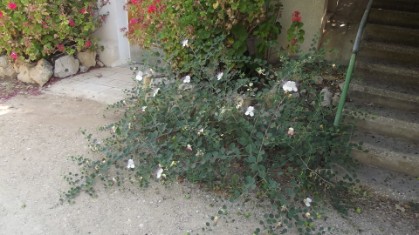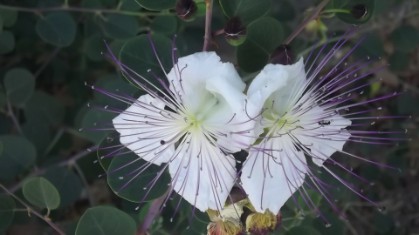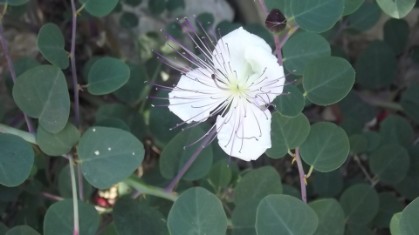Biblical Flora and Fauna Articles
Pronunciation Guide to botanical Latin names.
All About the Water Plant and The Shofar of Rosh Hashanah |
This is a beautiful meditation by Dr Sarah Oren, Curator of the Neot Kedumim Botanical Garden and its Head Botanist Ouria Orren
http://www.neot-kedumim.org.il/?CategoryID=269&ArticleID=279
(Vitex agnus-castus)

The vineyard has been “orphaned” (from the song Summer’s End, by Yossi Bachar) | ||
The Sages of the Talmud noted that “the end of the summer is harder than the summer itself” (Babylonian Talmud Yoma, 29a). Indeed, the summer heat and dryness do control nearly everything, except for plants that grow next to bodies of water. For those plants this is their “greatest hour.”
The blossoming period for plants that grow in water-rich environments is slower than for other plants. For one thing, water-rich soil has much less oxygen, thus slowing down the process. For another thing, water lowers the temperature of soil, also slowing the blossoming. When the plants finally do reach the peak of their bloom in the late summer, they do not have to compete with other plants to be pollinated.
One of the most prominent of these late-summer plants is the Vitex agnus-castus, known by several names in English, including Abraham’s Balm and Chaste Tree. This member of the verbenaceae plant family grows by bodies of water all over Israel, except for the Negev desert. It is a tall bush, reaching as high as two meters (approximately six and a half feet), with long branches and finger-shaped leaves that are divided into lobes. Its appearance is often confused with that of the medical cannabis plant.
During the winter, the plant has no leaves, and the ends of the branches have clusters of purplish-blue bilaterally symmetrical flowers that progressively open upwards. The tall, attractive appearance of the plant, combined with its impressively long flowering stage (June-September), has made the vitex agnus-castus a very popular addition to ornamental gardens. This is made possible by the fact that the roots of the plant have the ability to seek out ground water, thus enabling the plant to thrive even when far from a natural body of water. The ripe seeds have a hard shell that contains components that inhibit germination. These can only be neutralized after being washed with enough water to ensure germination. In the past, these seeds were used to make a powder that was believed to inhibit sexual desires and was used in monasteries. This use is the basis of two the plant’s English names – the Chaste Tree, and the Monk’s Pepper.
At Neot Kedumim, the plant can be found by the “Pool of the Willows” in the area known as “Four Species Hillside.” Because of its closeness to water, the Samaritans, an ethno religious group that claims to follow Torah law as it was before the Babylonian exile, believe that this is the plant referred to as the “willow of the brook” in Leviticus 23:40, which is used as one of the four species associated with the festival of Sukkoth (Feast of Tabernacles). |  | ||||
| |||||
| Vitex agnus-castus by the Pool of the Willows at Neot Kedumim. The plant, its flowers and its leaves (photo credit: Irit Shernicoff) | |||||
Genesis 22 relates the story of the Binding of Isaac, in which Abraham was commanded by God to sacrifice his son Isaac, who was only born after decades of Abraham’s beloved wife Sarah’s barrenness. In truth, he was not meant to kill his son; rather, he was being tested by the Lord to see to what extent his commitment and obedience would take him. When the angel stopped Abraham from harming Isaac, “Abraham looked and saw a ram caught in the thicket by his horns. Abraham went and took the ram, and offered him up as a sacrifice in place of his son.” (Genesis 22:13). One Jewish tradition teaches us that the bush in which the ram was caught was the vitex agnus-castus. The Latin name reflects this tradition (vitex (= life) agnus (= lamb) castus (= humble), that is to say “the life of the innocent lamb” – Isaac. A third name in English also reflects this tradition, Abraham’s balm, and the Hebrew name of the plant translates to “Abraham’s bush.”1
Ironically, while the seeds have components that inhibit sexual desires, studies have shown that the plant itself contains chemical components which help regulate hormonal activity, or can be used as a substitute. These components can assist with infertility, both for men and women, as well as increasing the production of breast milk in nursing mothers. There also those who claim that Abraham’s wife Sarah, was finally able to overcome her barrenness by using this plant, which led to the birth of Isaac.
The connection of this plant to this story is particularly appropriate now, as the Rosh Hashanah, the Jewish New Year is upon us. This is the time of year when the Abraham’s balm is in full bloom.
The Mishnah teaches us that “On Rosh Hashanah, all creatures of the world pass before [God]’ (Mishnah Rosh Hashanah 1:2). The period between Rosh Hashanah, the Day of Judgement, and Yom Kippur, the Day of Atonement is the period when every individual’s fate is said to be decreed.
Our Sages teach us that the Binding of Isaac took place on Rosh Hashanah. Indeed, on the second day of the holiday Genesis 22 is the biblical passage read in synagogues around the world. The shofar (ram’s horn) that we blow on Rosh Hashanah is to, among other things, remind God of our forefather Abraham’s commitment to His will, and to hopefully inspire His mercy upon us during this period of divine judgment.
The biblical verse referring to Rosh Hashanah says simply that on the “first day of the seventh month” it will be a “Yom Teru’ah”, the Day of the Blast (of horns, shofars) (Leviticus 23:24 and Numbers 29:1). The day is one of four “new years” according to Jewish tradition, and it falls at the beginning of the month of Tishrei, which is the seventh month of the year. In Jewish tradition the number 7 carries great significance - it represents divine intervention, the inclusion of holiness with the “normal.’ The division is not natural, similar to the Sabbath, the day of rest after six days of work, and the shmitta year, after six years of working the land, we allow it to lie fallow.
Tishrei marks the end of the summer, and the beginning of the agricultural year. Its name, which means “beginning” in Aramaic and Akkadian, was brought to the Land of Israel by those returning from the Babylonian exile with Ezra and Nehemiah, in the late 6th century-early 5th century BCE.
As we stand at the beginning of the seventh month, the beginning of our annual period of divine judgment. We are at the meeting point of heaven and earth, between nature, action, spirit and heritage.
Now it is upon us to welcome the New Year with hopes of reaping what the prophet Isaiah called the “good of the land” (Isaiah 1:19), and to hope for a successful, happy and healthy year.
The psalmist so beautifully brought nature together with spirit with his words, when he wrote that the one who delights in the word of the Lord will “be like a tree planted by streams of water, that brings forth fruit in its season, and whose leaf does not wither; and in all that he does, he will prosper.” (Psalms 1:3)
Wishing you all a happy and healthy New Year.

1 The tradition of the Binding of Isaac also made its way into the other two primary religions of the Middle East. According to Christianity, Jesus, the son of God is also referred to as the “Lamb of God” (Agnus dei), and Islamic tradition holds that Ishmael, Abraham’s son with his wife’s Egyptian handmaid Hagar, was the one nearly sacrificed. To this day, Muslims commemorate the historical event with Eid al-Adha, the Feast of the Sacrifice.
Caper (Capparis spinosa L.)
Ecclesiastes 12:5 – “ when men are afraid of heights and of dangers in the streets; when the almond tree blossoms and the grasshoppers drags himself along and DESIRE no longer is stirred. Then man goes to his eternal home and mourners go about the streets.”
Biblical scholars have long recognized that the word translated ‘desire’ is more likely a reference to a biblical plant; caper bush or Capparis spinoza L. or alternatively Capparis sicula Duham (the Palestine Caper).
Both the Septuagint (LXX) and the Vulgate translate the word ‘desire’ as caper.
Goodspeed, Jastnow, and the Douay use the word caper-berry in Ecclesiastes 12:5.
The Mishnah calls it ‘tzalaf’, which in the Bible can be found as a proper name. An example would be Nehemiah 3:30, as is Zelophehad (Numbers 26:33; Joshua 17:3; 1 Chronicles 7:15).
The Hebrew word ‘avionah’ is admittedly difficult to translate but there is sufficient weight of evidence to support that the caper bush, caper, caper-berry is a likely candidate for the otherwise awkward translation, desire.
So how do ‘desire’ and ‘caper’ relate to one another? Some have suggested that the plant may have aphrodisiac effects, thus the Greek word kapparis or a stimulant of hunger and thirst.
The caper flower is a marvel of creative design and beauty. The flower is large, white and consisting of four sepals, four petals, several long mauve stamens, and a single ovary on a long stalk.
Generally, it will open in the early evening and wilt by morning.
The caper fruits and buds have been eaten with delight for millennia. The Mediterranean world used capers in making sauces and even pickling the fruits in vinegar. That tradition continues to this day.
The caper is common, useful, beautiful, yet in modern times it has taken on an invasive nature. The plant will grow just about anywhere, in fact; it seems they will grow where no other species would. The caper is a thorny scrub bush that is a nuisance to many. In fact, as part of our gardening job we have to eradicate the caper bush on campus in most locations. We have decided to harvest some caper pods and try to pickle them. We’ll let you know how they taste in five months.
Sources: Zohary and Moldenke
Photos: Ed Bez- Yad Hashmona, Israel 2011.




Flora of Israel
Flowers in Israel
http://ww.flowersinisrael.com/
The Wild Flowers of Israel
http://wildflowers.co.il/english/about.asp
Module 12: Biblical Botany. Jim Duke.
http://www.ars-grin.gov/duke/syllabus/module12.htm
Catholic Encyclopedia. "Plants in the Bible". http://www.newadvent.org/cathen/12149a.htm
The Osgood Files (CBS Radio Network): 1/23/02. Religious Green thumbs cultivate plants of the Bible. http://www.acfnewsource.org/religion/biblical_garden.html
Reading for Horticulture course at Purdue. "Plants of the Bible". http://www.hort.purdue.edu/newcrop/history/lecture10/r_10-1.html
Plants of the Bible (Bible studies). http://www.scribd.com/doc/8942311/Plants-Of-The-Bible
Biblical Flowers. http://www.angelfire.com/journal2/flowers/pcd15.html
Jewish festival of trees.
http://en.wikipedia.org/wiki/Tu_Bishvat
Beautiful photos of flora and fauna in Israel
Plants of the Bible: symbols, parables and healing. Vincenzina Krymow.
http://www.americancatholic.org/Newsletters/SFS/an0304.asp
Methuselah
Ancient Bible References to Date Palm Trees, Phoenix dactylifera
By Patrick Malcolm
http://www.swedbible.org/Ancient_Bible_References.html
Extinct Tree From Christ's Time Rises From the Dead - By Clara Moskowitz-http://www.livescience.com/history/080612-methuselah-tree.html
Recent Update - 2014
http://holylandphotos.wordpress.com/2014/07/14/methuselah-the-palm-tree/
4000 year old Lentil
4000 year old Lentil sprouting
http://www.hurriyetdailynews.com/n.php?n=ancient-seed-came-into-leaf-2009-12-16
Flora of Egypt
The Flowers of Ancient Egypt.
http://www.touregypt.net/featurestories/flowers.htm
Biblical Plants and Medicine
Ever since pre-historic times human beings turned to the flora around them for finding medications. Plants have evolved a variety of substances that have a wide array of physiological, antibiotic and other therapeutic effects. Folk medicine learned to use these substances for the benefit of mankind. In modern medicine we also make use of many plant derived substances.
A word of caution – identifying a plant here as "medicinal" does not constitute a recommendation for its use in any medical application. On the contrary, it is likely to be toxic, if used improperly
Ancient wine spiked with Meds.
http://news.nationalgeographic.com/news/2009/04/090413-scorpion-king-wine.html?source=rss
Thoughts about the medicinal uses of Frankincense
Medicinal use of Frankincense
Identifying biblical henna
http://ferrelljenkins.wordpress.com/2013/02/12/like-a-cluster-of-henna/
My beloved is to me a cluster of henna blossoms in the vineyards of Engedi. (Song of Solomon [Canticles] 1:14 ESV; see also 4:13)
Lawsonia alba or Lawsonia inermis?
Philistines introduced new plants to the coastal plain
- Cumin (Cuminum cyminum), found at Aphek in the early Iron Age.
- Sycamore (Ficus sycomorus) found at Ashkelon in the late Iron Age.
- Opium poppy (Papaver somniferum) found at Ashkelon in the late Iron Age.
Cumin and sycamore came from the Eastern Mediterranean, but opium came from west Europe.
Rock Hyrax - (from Greek ὕραξ "shrewmouse") or Procavia capensis well-furred, rotund creatures with short tails. Most measure between 30 and 70 cm long and weigh between 2 and 5 kg.
The words "rabbit", "hare" or "coney" appear as terms for the hyrax in some English translations of the Bible. Early English translators had no knowledge of the hyrax (Hebrew שָּׁפָן shaphan]), and therefore no name for them. There are references to hyraxes in the Old Testament,] particularly in Leviticus 11, where they are described as lacking a split hoof and therefore being not kosher. It also claims that the hyrax chews its cud. However, this claim is due to the habit of the hyrax chewing without having ingested anything, resembling the chewing of cud. Some of the modern translations refer to them as rock badgers.Shaphan was also the name of a scribe of King Josiah.
Photo by Ed Bez, Ein Gedi, Israel, November 2011

